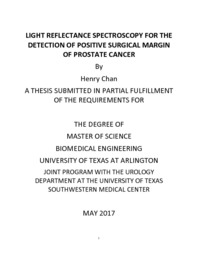
ATTENTION: The works hosted here are being migrated to a new repository that will consolidate resources, improve discoverability, and better show UTA's research impact on the global community. We will update authors as the migration progresses. Please see MavMatrix for more information.
Show simple item record
| dc.contributor.advisor | Liu, Hanli | |
| dc.contributor.advisor | Cadeddu, Jeffrey | |
| dc.creator | Chan, Henry Thek | |
| dc.date.accessioned | 2023-09-11T15:21:15Z | |
| dc.date.available | 2023-09-11T15:21:15Z | |
| dc.date.created | 2017-05 | |
| dc.date.submitted | May 2017 | |
| dc.identifier.uri | http://hdl.handle.net/10106/31701 | |
| dc.description.abstract | During a radical prostatectomy in the operating room, there exists a certain degree of risks of a surgical positive margin of prostate cancer. Positive surgical margins are defined as cancer that has spread beyond the margin of the prostate and into the surrounding tissues. Surgeons will be able to utilized the concept of Light Reflectance Spectroscopy (LRS) in real-time during surgery to help detect these positive surgical margins and to provide the surgeon a quantitative decision to remove the excess surrounding tissues. This modality would essentially lower the risks of positive surgical margins and prevent the recurrence of cancer, effectively improving the survival of the patient. LRS is highly dependent on the Gleason Score (GS) of the cancer. Based off the 5 and 9 Feature Algorithm, select features of the spectral curve are used to differentiate between normal tissue and cancerous tissue. It is most effective in distinguishing between normal tissue versus high grade cancers such as GS 4+3 and GS 4+4, primarily due to the Gleason Grade 4 pattern. But LRS is less effective in distinguishing lower grade cancers such as GS 6 (3+3) and GS 3+4, primarily due to the Gleason Grade 3 pattern. The 5 Feature Algorithm is the current optimal form of cancer classification algorithm for higher grade cancers, with a Sensitivity and Specificity value of 72.2% and 81.5%, respectively, for the GS 4+4 groups. In addition, there is a question if applying an excess level of pressure onto the surface of the prostate using the optical probe would affect the spectral readings of the LRS measurement. It was found that applying pressures up to ~0.066 N/mm2 does not significantly affect the spectral readings at a peak wavelength value of 630 nm. Also, two new optical probes, a new 370 µm probe and a new 125 µm, were introduced into the study and the penetration depths were calculated. It was found that the new 370 µm probe had a penetration depth range from 1.77 mm to 1.95 mm. The new 125 µm probe had a penetration depth range from 1.06 mm to 1.41 mm. | |
| dc.format.mimetype | application/pdf | |
| dc.language.iso | en_US | |
| dc.subject | Light Reflectance Spectroscopy | |
| dc.subject | Prostate Cancer | |
| dc.subject | Positive Surgical Margin | |
| dc.title | LIGHT REFLECTANCE SPECTROSCOPY FOR THE DETECTION OF POSITIVE SURGICAL MARGIN OF PROSTATE CANCER | |
| dc.type | Thesis | |
| dc.date.updated | 2023-09-11T15:21:16Z | |
| thesis.degree.department | Bioengineering | |
| thesis.degree.grantor | The University of Texas at Arlington | |
| thesis.degree.level | Masters | |
| thesis.degree.name | Master of Science in Biomedical Engineering | |
| dc.type.material | text | |
| dc.creator.orcid | 0000-0002-8200-4085 | |
Files in this item
- Name:
- CHAN-THESIS-2017.pdf
- Size:
- 2.310Mb
- Format:
- PDF
This item appears in the following Collection(s)
Show simple item record


